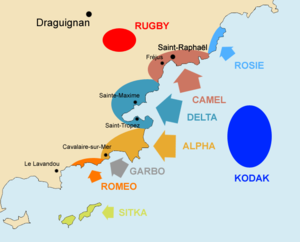| 2nd Parachute Brigade in Southern France | |||||||
|---|---|---|---|---|---|---|---|
| Part of Operation Dragoon | |||||||
 Map of the Dragoon landings, the airborne landings Operation Rugby highlighted in red | |||||||
| |||||||
| Belligerents | |||||||
|
|
| ||||||
| Commanders and leaders | |||||||
| Charles Hilary Vaughan Pritchard | Johannes Baessler | ||||||
| Units involved | |||||||
| 2nd Parachute Brigade | 242nd Infantry Division | ||||||
| Casualties and losses | |||||||
|
51 dead 130 wounded 181 missing ^ | Unknown but around 350 prisoners taken[1] | ||||||
| ^ Some of the missing later reported for duty | |||||||
The British 2nd Parachute Brigade was part of the Operation Rugby airborne landings in August 1944. The operation was carried out by an ad hoc airborne formation called the 1st Airborne Task Force. Operation Rugby was itself part of the Operation Dragoon invasion of Southern France by the American 7th Army. The airborne task force landed in the River Argens valley with the objective of preventing German reinforcements from reaching the landing beaches. The landings were mainly an American operation and the brigade was the only British Army formation involved.[2]
The brigade's pathfinders landed accurately and set up their homing beacons, but the main body of the brigade landed over a large area, some 20 miles (32 km) away. The following glider force also had problems; weather conditions forced the brigade's anti-tank unit to turn back for Italy and return with the second wave later that day. Eventually the brigade captured their primary objectives, but the lack of manpower meant that their secondary objective of Le Muy was given to the American airborne forces. The seaborne and airborne landings linked up within two days, and the brigade became the reserve formation for the operation.
As a British withdrawal from France at the earliest opportunity had been the original intent, the brigade boarded ships bound for Italy eleven days after landing. The operation had cost the brigade 362 casualties, but this did not hinder their next mission in Greece two months later. Only 126 replacements were required to bring the brigade back up to full strength.
